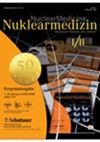Oligometastatic disease in biochemical recurrence of prostate cancer: Prevalence on PSMA PET/CT and consecutive metastasis-directed therapy - Experience at a tertiary referral center.
IF 1
4区 医学
Q4 RADIOLOGY, NUCLEAR MEDICINE & MEDICAL IMAGING
引用次数: 3
Abstract
AIM The aim of our study was to address the prevalence of oligometastatic recurrent prostate cancer (PCa) on PSMA-PET and the associated practice of metastasis-directed therapy (MDT). Next, we aimed to determine a PSA threshold below which most patients had local and/or oligometastatic recurrence on PSMA-PET. METHODS One hundred and ten consecutive patients with biochemical recurrence (BCR) after radical prostatectomy (RP) ± radiation were referred for 68Ga-PSMA-11 or 18F-DCFPyL PET/CT. We correlated the location and number of PSMA-positive lesions against the treatment choice after imaging. Detection rates were stratified by PSA levels at the time of PET/CT. The study design was monocentric retrospective. RESULTS Thirty-four patients (30.9%) had a PSMA-negative scan, while 17 (15.5%) had local recurrence and 59 (53.6%) had metastatic recurrence on PSMA-PET. ROC analysis revealed a cut-off of ≤3 metastatic lesions on PSMA-PET for the steering of treatment decisions towards MDT rather than solely systemic therapy (AUC: 0.88). Defined as 3 or fewer metastatic lesions, oligometastatic recurrent PCa was found in up to 30% (33/110) of all patients. At PSA levels below 3.5 ng/ml, the rate of PSMA-positive disease that was locally confined or oligometastatic was 76% (45/59), dropping significantly to 29.4% (5/17) above this threshold (p<0.001) as polymetastatic findings became more frequent. CONCLUSION The detection of ≤3 oligometastases on PSMA-PET encouraged the consecutive pursuit of MDT instead of systemic therapy alone. PSMA-PET predominantly captured patients at recurrence stages amenable to localized treatment when initiated at PSA levels below 3.5 ng/ml.前列腺癌生化复发中的少转移性疾病:PSMA PET/CT的患病率和连续的转移性治疗-三级转诊中心的经验
目的:本研究的目的是探讨PSMA-PET检查中低转移性复发性前列腺癌(PCa)的患病率以及相关的转移定向治疗(MDT)的实践。接下来,我们的目标是确定PSA阈值,低于该阈值,大多数患者在PSMA-PET上发生局部和/或少转移性复发。方法连续110例根治性前列腺切除术(RP)术后生化复发(BCR)患者行68Ga-PSMA-11或18F-DCFPyL PET/CT检查。我们将psma阳性病变的位置和数量与成像后的治疗选择相关联。根据PET/CT时PSA水平对检出率进行分层。研究设计为单中心回顾性研究。结果PSMA-PET扫描阴性34例(30.9%),局部复发17例(15.5%),转移复发59例(53.6%)。ROC分析显示PSMA-PET上≤3个转移灶的临界值用于指导治疗决策,而不是单纯的全身治疗(AUC: 0.88)。定义为3个或更少的转移灶,在所有患者中发现高达30%(33/110)的低转移性复发性PCa。当PSA水平低于3.5 ng/ml时,局部局限或低转移性PSA阳性疾病的发生率为76%(45/59),随着多转移的发现变得更加频繁,PSA阳性疾病的发生率显著下降至29.4%(5/17)。结论PSMA-PET检测≤3个寡转移灶,鼓励患者继续进行MDT治疗,而不是单纯的全身治疗。当PSA水平低于3.5 ng/ml时,PSMA-PET主要捕获复发阶段可进行局部治疗的患者。
本文章由计算机程序翻译,如有差异,请以英文原文为准。
求助全文
约1分钟内获得全文
求助全文
来源期刊
CiteScore
1.70
自引率
13.30%
发文量
267
审稿时长
>12 weeks
期刊介绍:
Als Standes- und Fachorgan (Organ von Deutscher Gesellschaft für Nuklearmedizin (DGN), Österreichischer Gesellschaft für Nuklearmedizin und Molekulare Bildgebung (ÖGN), Schweizerischer Gesellschaft für Nuklearmedizin (SGNM, SSNM)) von hohem wissenschaftlichen Anspruch befasst sich die CME-zertifizierte Nuklearmedizin/ NuclearMedicine mit Diagnostik und Therapie in der Nuklearmedizin und dem Strahlenschutz: Originalien, Übersichtsarbeiten, Referate und Kongressberichte stellen aktuelle Themen der Diagnose und Therapie dar.
Ausführliche Berichte aus den DGN-Arbeitskreisen, Nachrichten aus Forschung und Industrie sowie Beschreibungen innovativer technischer Geräte, Einrichtungen und Systeme runden das Konzept ab.
Die Abstracts der Jahrestagungen dreier europäischer Fachgesellschaften sind Bestandteil der Kongressausgaben.
Nuklearmedizin erscheint regelmäßig mit sechs Ausgaben pro Jahr und richtet sich vor allem an Nuklearmediziner, Radiologen, Strahlentherapeuten, Medizinphysiker und Radiopharmazeuten.

 求助内容:
求助内容: 应助结果提醒方式:
应助结果提醒方式:


